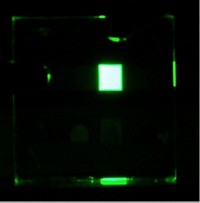Advertisement
Grab your lab coat. Let's get started
Welcome!
Welcome!
Create an account below to get 6 C&EN articles per month, receive newsletters and more - all free.
It seems this is your first time logging in online. Please enter the following information to continue.
As an ACS member you automatically get access to this site. All we need is few more details to create your reading experience.
Not you? Sign in with a different account.
Not you? Sign in with a different account.
ERROR 1
ERROR 1
ERROR 2
ERROR 2
ERROR 2
ERROR 2
ERROR 2
Password and Confirm password must match.
If you have an ACS member number, please enter it here so we can link this account to your membership. (optional)
ERROR 2
ACS values your privacy. By submitting your information, you are gaining access to C&EN and subscribing to our weekly newsletter. We use the information you provide to make your reading experience better, and we will never sell your data to third party members.
Materials
Paint-On Solar Cells
Photovoltaic paints coated on electrodes would be cheap and easy to make
by Journal News and Community
December 19, 2011
| A version of this story appeared in
Volume 89, Issue 51
To fabricate solar cells, technicians may someday trade their clean-room garb for a paint smock. Researchers led by Prashant V. Kamat of the University of Notre Dame have developed “solar paints” made of a paste containing semiconducting nanoparticles (ACS Nano, DOI: 10.1021/nn204381g). The paints could lead to cheaper and easier-to-produce solar cells. Silicon-based solar cells have a high price tag because of the specialized protocols and equipment needed to make them, Kamat says. To simplify the design and lower those costs, Kamat and his colleagues wanted to develop silicon-free cells based on quantum dot nanomaterials that someone could simply paint onto any conductive surface. The team’s solar paints contain a titanium dioxide nanoparticle core coated with either cadmium sulfide or cadmium selenide. When a photon with the right energy hits the cadmium compounds, an electron escapes and TiO2 absorbs it. The researchers found that the most efficient of these first-generation paints—with a light-to-electricity conversion efficiency of 1%—was a mixture of both CdS- and CdSe-coated nanoparticles; commercial silicon solar cells have efficiencies between 10 and 15%. Kamat and his team next plan to study paint stability, as well as work to increase the efficiency.





Join the conversation
Contact the reporter
Submit a Letter to the Editor for publication
Engage with us on Twitter